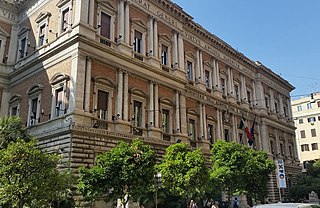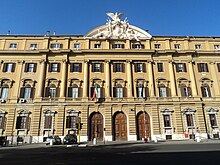
The Polizia di Stato is one of the national police forces of Italy. Alongside the Carabinieri, it is the main police force for providing police duties, primarily to cities and large towns, and with its child agencies it is also responsible for highway patrol (autostrade), railways (ferrovie), airports (aeroporti), customs as well as certain waterways, and assisting the local police forces.

Law enforcement in Italy is centralized on a national level, carried out by multiple national forces, helped by few limited local agencies. The Italian law enforcement system is considered complex, with multiple police forces and other agencies taking part in different duties. Policing in the Italian system refers to the duties of "full-powered officers" coming from the four national main forces: Polizia di Stato, Carabinieri, Polizia Penitenziaria and Guardia di Finanza. While the duties of these four corps' include investigating arresting, other local forces carry out limited duties.

The Libro d'Oro, originally published between 1315 and 1797, is the formal directory of nobles in the Republic of Venice. It has been resurrected as the Libro d'Oro della Nobiltà Italiana, a privately published directory of the nobility of Italy. The book lists some of Italy's noble families and their cadet branches.

The Consulta Araldica was a college instituted by royal decree on 10 October 1869 to advise the Italian government on noble titles, coats of arms and related matters. It was a department of the Ministry of the Interior, combining the roles of the various heraldic colleges which had existed in pre-unification Italy, including the Tribunale Araldico of Lombardy, the Commissione Araldica of Venice and the Congregazione Araldica Capitolina of Rome.

The Ministry of Defence is the government body of the Italian Republic responsible for military and civil defence matters and managing the Italian Armed Forces. It is led by the Italian Minister of Defence, a position occupied by Guido Crosetto since October 2022.

The Casa del Fascio of Como, also called Palazzo Terragni, is a building located in Como, Italy, in the Piazza del Popolo, and it is one of the masterpieces of Italian Modern Architecture. It was designed by Italian architect Giuseppe Terragni (1904-1943). It was inaugurated in 1936 as the local office of the National Fascist Party. After the fall of Fascism in 1945, it was used by the National Liberation Committee Parties and in 1957, it became the headquarters of the local Finance Police, who still occupy it. The building has a square plan and four stories.

The Italian Istituto Poligrafico e Zecca dello Stato (IPZS), founded in 1928, is situated at the via Salaria 691 in Rome. As well as producing coins, passports, and postage stamps for Italy, it serves the micro-states of the Vatican City, San Marino, and the Sovereign Military Order of Malta. It also publishes books under the imprint Libreria dello Stato. The O.C.V. and traditional productions factory, the multimedial production institute and the Mint are also located in the capital. Other factories are located in Verrès, Val d'Aosta, and Foggia, Apulia. Banknotes are produced by the Bank of Italy.

The Ministry of Agriculture, Food Sovereignty and Forests, Italian: Ministero dell'agricoltura, della sovranità alimentare e delle foreste or MASAF, is an Italian government department.

The Ministry of Enterprises and Made in Italy, commonly known under the shortening it's pre-2022 name MISE, is a government ministry of the Italian Republic. It deals with production, economic activities, energy and mineral resources, telecommunications, consumers, tourism, internationalisation and business incentives. It was formed in 2006 after the reorganization of the Ministry of Productive Activities to which were merged the Ministry of Communications and the Ministry of International Trade in 2008.
The Polizia Postale e delle Comunicazioni is one of the units of the Polizia di Stato, the State Police of Italy. Its functions include the investigation of cybercrime.
The Direzione Investigativa Antimafia (DIA), also known as the Anti-Mafia Investigation Division, is an Italian multi-force investigation body under the Department of Public Security of the Ministry of the Interior. Its main task is the fight against the mafia-related organized crime in Italy.
Cassa di Risparmio del Friuli Venezia Giulia S.p.A. known as CariFVG in short, was an Italian savings bank based in Gorizia, Friuli – Venezia Giulia region.

INA Assitalia S.p.A. was an insurance company, operating on the Italian market from 1912 to 2013. In the last years it belonged to the Assicurazioni Generali group.
The Istituto nazionale per l'assicurazione contro gli infortuni sul lavoro, or INAIL, is an Italian statutory corporation overseen by the Ministry of Labour and Social Policies. Its headquarters is in the INAIL Tower in the EUR, Rome.

The Gelmini reform refers to the set of acts of the Italian Republic – issued during the Berlusconi IV Cabinet – concerning the education sector in Italy.

A Ministry of the Republic of Italy is an administrative organ of the Republic of Italy, placed at the top of Italian public administration and is characterised by one or more specific competencies, with an organised structure, often varying over time.
The Police ranks of Italian police officers denote the position of a given officer in the police hierarchy in Italian police forces.
Eustachio Pisani was an Italian entrepreneur.
Dario Scannapieco is an Italian economist and business executive. Since June 2021 he has been CEO of Cassa Depositi e Prestiti.
Funding to the Italian Catholic Church from the Italian state includes direct funding and other types of economic and financial burdens, including:













